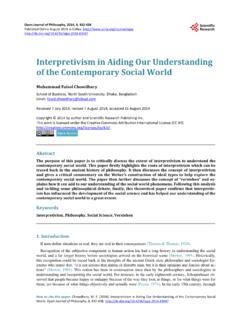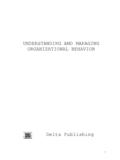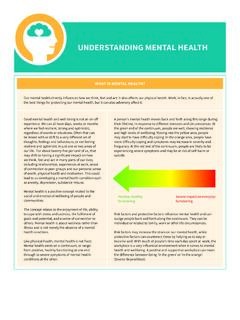Transcription of Understanding deep learning requires rethinking …
1 Understanding deep learning requires RE-THINKING GENERALIZATIONC hiyuan Zhang Massachusetts Institute of BengioGoogle HardtGoogle Recht University of California, VinyalsGoogle their massive size, successful deep artificial neural networks can exhibit aremarkably small difference between training and test performance. Conventionalwisdom attributes small generalization error either to properties of the model fam-ily, or to the regularization techniques used during extensive systematic experiments, we show how these traditional ap-proaches fail to explain why large neural networks generalize well in , our experiments establish that state-of-the-art convolutional networksfor image classification trained with stochastic gradient methods easily fit a ran-dom labeling of the training data.
2 This phenomenon is qualitatively unaffectedby explicit regularization, and occurs even if we replace the true images by com-pletely unstructured random noise. We corroborate these experimental findingswith a theoretical construction showing that simple depth two neural networks al-ready have perfect finite sample expressivity as soon as the number of parametersexceeds the number of data points as it usually does in interpret our experimental findings by comparison with traditional artificial neural networks often have far more trainable model parameters than the number ofsamples they are trained on. Nonetheless, some of these models exhibit remarkably smallgener-alization error, , difference between training error and test error . At the same time, it iscertainly easy to come up with natural model architectures that generalize poorly.
3 What is it thenthat distinguishes neural networks that generalize well from those that don t? A satisfying answerto this question would not only help to make neural networks more interpretable, but it might alsolead to more principled and reliable model architecture answer such a question, statistical learning theory has proposed a number of different complexitymeasures that are capable of controlling generalization error. These include VC dimension (Vapnik,1998), Rademacher complexity (Bartlett & Mendelson, 2003), and uniform stability (Mukherjeeet al., 2002; Bousquet & Elisseeff, 2002; Poggio et al., 2004). Moreover, when the number ofparameters is large, theory suggests that some form of regularization is needed to ensure smallgeneralization error.
4 Regularization may also be implicit as is the case with early CONTRIBUTIONSIn this work, we problematize the traditional view of generalization by showing that it is incapableof distinguishing between different neural networks that have radically different generalization per-formance. Work performed while interning at Google Brain. Work performed at Google [ ] 26 Feb 2017 Randomization the heart of our methodology is a variant of the well-known randomiza-tion test from non-parametric statistics (Edgington & Onghena, 2007). In a first set of experiments,we train several standard architectures on a copy of the data where the true labels were replaced byrandom labels. Our central finding can be summarized as: deep neural networks easily fit random precisely, when trained on a completely random labeling of the true data, neural networksachieve0training error.
5 The test error, of course, is no better than random chance as there is nocorrelation between the training labels and the test labels. In other words, by randomizing labelsalone we can force the generalization error of a model to jump up considerably without changingthe model, its size, hyperparameters, or the optimizer. We establish this fact for several differentstandard architectures trained on the CIFAR10 and ImageNet classification benchmarks. Whilesimple to state, this observation has profound implications from a statistical learning perspective:1. The effective capacity of neural networks is sufficient for memorizing the entire data Even optimization on random labels remains easy. In fact, training time increases only bya small constant factor compared with training on the true Randomizing labels is solely a data transformation, leaving all other properties of the learn-ing problem on this first set of experiments, we also replace the true images by completely randompixels ( , Gaussian noise) and observe that convolutional neural networks continue to fit the datawith zero training error.
6 This shows that despite their structure, convolutional neural nets can fitrandom noise. We furthermore vary the amount of randomization, interpolating smoothly betweenthe case of no noise and complete noise. This leads to a range of intermediate learning problemswhere there remains some level of signal in the labels. We observe a steady deterioration of thegeneralization error as we increase the noise level. This shows that neural networks are able tocapture the remaining signal in the data, while at the same time fit the noisy part using discuss in further detail below how these observations rule out all of VC-dimension, Rademachercomplexity, and uniform stability as possible explanations for the generalization performance ofstate-of-the-art neural role of explicit the model architecture itself isn t a sufficient regularizer, itremains to see how much explicit regularization helps.
7 We show that explicit forms of regularization,such as weight decay, dropout, and data augmentation, do not adequately explain the generalizationerror of neural networks. Put differently:Explicit regularization may improve generalization performance, but is neither necessary nor byitself sufficient for controlling generalization contrast with classical convex empirical risk minimization, where explicit regularization is nec-essary to rule out trivial solutions, we found that regularization plays a rather different role in deeplearning. It appears to be more of a tuning parameter that often helps improve the final test errorof a model, but the absence of all regularization does not necessarily imply poor generalization er-ror. As reported by Krizhevsky et al.
8 (2012),`2-regularization (weight decay) sometimes even helpsoptimization, illustrating its poorly understood nature in deep sample complement our empirical observations with a theoretical con-struction showing that generically large neural networks can express any labeling of the trainingdata. More formally, we exhibit a very simple two-layer ReLU network withp= 2n+dparametersthat can express any labeling of any sample of sizeninddimensions. A previous construction dueto Livni et al. (2014) achieved a similar result with far more parameters, namely,O(dn).While ourdepth2network inevitably has large width, we can also come up with a depthknetwork in whicheach layer has onlyO(n/k) prior expressivity results focused on what functions neural nets can represent over the entiredomain, we focus instead on the expressivity of neural nets with regards to a finite sample.
9 Incontrast to existing depth separations (Delalleau & Bengio, 2011; Eldan & Shamir, 2016; Telgarsky,2016; Cohen & Shashua, 2016) in function space, our result shows that even depth-2networks oflinear size can already represent any labeling of the training role of implicit explicit regularizers like dropout and weight-decaymay not be essential for generalization , it is certainly the case that not all models that fit the trainingdata well generalize well. Indeed, in neural networks, we almost always choose our model as theoutput of running stochastic gradient descent. Appealing to linear models, we analyze how SGDacts as an implicit regularizer. For linear models, SGD always converges to a solution with smallnorm. Hence, the algorithm itself is implicitly regularizing the solution.
10 Indeed, we show on smalldata sets that even Gaussian kernel methods can generalize well with no regularization. Though thisdoesn t explain why certain architectures generalize better than other architectures, it does suggestthat more investigation is needed to understand exactly what the properties are inherited by modelsthat were trained using WORKH ardt et al. (2016) give an upper bound on the generalization error of a model trained with stochasticgradient descent in terms of the number of steps gradient descent took. Their analysis goes throughthe notion ofuniform stability(Bousquet & Elisseeff, 2002). As we point out in this work, uniformstability of a learning algorithm is independent of the labeling of the training data. Hence, theconcept is not strong enough to distinguish between the models trained on the true labels (smallgeneralization error) and models trained on random labels (high generalization error).
![arXiv:0706.3639v1 [cs.AI] 25 Jun 2007](/cache/preview/4/1/3/9/3/1/4/b/thumb-4139314b93ef86b7b4c2d05ebcc88e46.jpg)

![arXiv:1301.3781v3 [cs.CL] 7 Sep 2013](/cache/preview/4/d/5/0/4/3/4/0/thumb-4d504340120163c0bdf3f4678d8d217f.jpg)
![@google.com arXiv:1609.03499v2 [cs.SD] 19 Sep 2016](/cache/preview/c/3/4/9/4/6/9/b/thumb-c349469b499107d21e221f2ac908f8b2.jpg)














